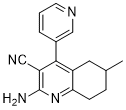BRD6989 is an analog of the naturally occurng cortistatin A (dCA), acting as a novel, potent and selective CDK8 inhibitor with an IC50 of ~200 nM. BRD6989 requires an intact cyclin C-CDK8 complex in order to upregulate IL-10, a function that is recapitulated by several structurally distinct CDK8 and CDK19 inhibitors. BRD6989 showed a strong preference for CDK8 over CDK19. BRD6989 increased IL-10 production and inhibited STAT1 phosphorylation at S727 in bone marrow-derived dendritic cells, indicating that CDK8 functions as a negative regulator of IL-10 production during innate immune activation. For inflammatory conditions, BRD6989 might be helpful.
Physicochemical Properties
| Molecular Formula | C16H16N4 |
| Molecular Weight | 264.332 |
| Exact Mass | 264.137 |
| Elemental Analysis | C, 72.70; H, 6.10; N, 21.20 |
| CAS # | 642008-81-9 |
| Related CAS # | 642008-81-9 |
| PubChem CID | 3835861 |
| Appearance | Off-white to light yellow solid powder |
| Density | 1.2±0.1 g/cm3 |
| Boiling Point | 496.6±45.0 °C at 760 mmHg |
| Flash Point | 254.2±28.7 °C |
| Vapour Pressure | 0.0±1.3 mmHg at 25°C |
| Index of Refraction | 1.640 |
| LogP | 3.69 |
| Hydrogen Bond Donor Count | 1 |
| Hydrogen Bond Acceptor Count | 4 |
| Rotatable Bond Count | 1 |
| Heavy Atom Count | 20 |
| Complexity | 387 |
| Defined Atom Stereocenter Count | 0 |
| SMILES | C(C1=C(N=C2CCC(C)CC2=C1C1=CN=CC=C1)N)#N |
| InChi Key | QSYBDNXNOJIKML-UHFFFAOYSA-N |
| InChi Code | InChI=1S/C16H16N4/c1-10-4-5-14-12(7-10)15(11-3-2-6-19-9-11)13(8-17)16(18)20-14/h2-3,6,9-10H,4-5,7H2,1H3,(H2,18,20) |
| Chemical Name | 2-amino-6-methyl-4-pyridin-3-yl-5,6,7,8-tetrahydroquinoline-3-carbonitrile |
| Synonyms | BRD-6989; BRD6989; BRD 6989 |
| HS Tariff Code | 2934.99.9001 |
| Storage |
Powder-20°C 3 years 4°C 2 years In solvent -80°C 6 months -20°C 1 month |
| Shipping Condition | Room temperature (This product is stable at ambient temperature for a few days during ordinary shipping and time spent in Customs) |
Biological Activity
| Targets | CDK8 (IC50 ~200 nM); recombinant CDK8 (IC50 ~0.5 μM); recombinant CDK19 (IC50 >30 μM); IL-10 |
| ln Vitro | Using BRD6989 (0-100 μM; 48 hours) to ablate BMDCs results in an EC50 trajectory of 1 μM for IL-10 production [1]. IFNγ-stimulated BMDCs are inhibited at Ser727 by BRD6989 (0.6, 1.7, 5, 15 μM). After stimulating BMDMs, BRD6989 (5 μM; ~2 hours) differentially suppresses STAT1–STAT2 activity and phosphorylation of the NF-κB activation domain [1]. BRD6989 (^2 hours; 5 µM). 24 hours) increases the synthesis of IL-10 and activator in mouse dendritic cells and macrophages [1]. |
| References |
[1]. Small-molecule studies identify CDK8 as a regulator of IL-10 in myeloid cells. Nat Chem Biol. 2017 Oct;13(10):1102-1108. |
| Additional Infomation | 2-amino-6-methyl-4-(3-pyridinyl)-5,6,7,8-tetrahydroquinoline-3-carbonitrile is a member of bipyridines. |
Solubility Data
| Solubility (In Vitro) | DMSO: 25~30 mg/mL (94.6~113.5 mM) |
| Solubility (In Vivo) |
Solubility in Formulation 1: ≥ 2.08 mg/mL (7.87 mM) (saturation unknown) in 10% DMSO + 90% Corn Oil (add these co-solvents sequentially from left to right, and one by one), clear solution. For example, if 1 mL of working solution is to be prepared, you can add 100 μL of 20.8 mg/mL clear DMSO stock solution to 900 μL of corn oil and mix evenly. (Please use freshly prepared in vivo formulations for optimal results.) |
| Preparing Stock Solutions | 1 mg | 5 mg | 10 mg | |
| 1 mM | 3.7831 mL | 18.9157 mL | 37.8315 mL | |
| 5 mM | 0.7566 mL | 3.7831 mL | 7.5663 mL | |
| 10 mM | 0.3783 mL | 1.8916 mL | 3.7831 mL |
